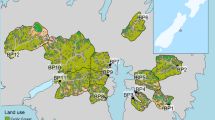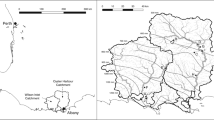Abstract
Phosphate interacts with inorganic sediment particles through sorption reactions in streams. Collectively, this phosphorus (P) buffering mechanism can be an important determinant of soluble reactive P (SRP) concentrations. If sorption reactions control SRP concentrations in a stream, then differences in sediment characteristics may cause spatial differences in SRP concentrations. This prediction was tested by examining sediment-buffering characteristics and spatial variation in SRP among reaches with distinct sediment composition (i.e., fine versus coarse particles) in two tributaries of Boulder Creek, a headwater stream in central Wisconsin. SRP concentrations were significantly lower and algal available P and P sorption capacity were significantly higher in the reach dominated by fine sediments. Although fine particles such as sand had the greatest P sorption capacity, no retention could be attributed to biotic processes, whereas over 50% of P retention in coarse particles such as gravel could be linked to biotic uptake. Equilibrium P concentration (EPC0) assays from different sediment fractions also indicate that biotic uptake is relatively unimportant in sand particles (EPClive 10 μg/L: EPCkilled 10 μg/L) but very important in gravel or larger particles (EPClive 10 μg/L: EPCkilled 80 μg/L). Thus, sediment influence on stream water P concentrations can shift predictably from abiotic sorption in reaches with fine particles to biotic retention in areas dominated by coarse sediments. Consequently, changes in sediment composition due to natural or anthropogenic disturbance have the potential to alter the type and strength of sediment-associated processes determining ambient stream P concentrations.









Similar content being viewed by others
References
American Public Health Association (1995) Standard methods for the examination of water and wastewater, 19th edn. Washington, DC
Bache BW, Williams EG (1971) A phosphate sorption index for soils. J Soil Sci 22:289–301
Bunte K, Abt SR (2001) Sampling surface subsurface particle-size distributions in wadable gravel- and cobble-bed streams for analyses in sediment transport, hydraulics, and streambed monitoring. United States Department of Agriculture, Forest Service General Technical Report RMRS-GTR-74
Bothwell ML (1985) Phosphorus limitation of lotic periphyton growth rates: an intersite comparison using continuous-flow troughs (Thompson River system, British Columbia). Limnol Oceanogr 30:527–542
Burkett EB, Gusftason SK (1995) Use of video image analysis for assessment of coral reef structure. In: Proceedings of the St. Mary’s University Research Symposium, Winona, MN, pp 1–10
Cody ML (1974) Competition and the structure of bird communities. Princeton University Press, Princeton, NJ
Collier M, Webb RH, Schmidt JC (1996) Dams and rivers: primer on the downstream effects of dams. US Geological Survey Circular 1126. Tucson, AZ
Doyle MW, Stanley EH, Harbor JM (2003a) Channel adjustments following two dam removals in Wisconsin. Water Resour Res 39:10.1029/2002WR001714
Doyle MW, Stanley EH, Harbor JM (2003b) Hydrogeomorphic controls on phosphorus retention in streams. Water Resour Res 39:10.1029/2003WR002038
Duffer WR, Dorris TC (1966) Primary productivity in a southern Great Plains stream. Limnol Oceanogr 11:143–151
Elliott ET, Heil JW, Kelly EF, Monger HC (1999) Soil structural and other physical properties. In: Robertson GP, Coleman DC, Bledsoe CS, Sollins P (eds) Stand soil methods for long-term ecological research. Oxford University Press, New York
Elwood JW, Newbold JD, Trimble AF, Stark RW (1981) The limiting role of phosphorus in a woodland stream ecosystem: Effects of P enrichment on leaf decomposition and primary producers. Ecology 62:146–464
Froelich PN (1988) Kinetic control of dissolved phosphate in natural rivers and estuaries: A primer on the phosphate buffer mechanism. Limnol Oceanogr 33:649–668
Gainswin BE, House WA, Leadbeater BSC, Armitage PD, Patten J (2006) The effects of sediment size fraction and associated algal biofilms on the kinetics of phosphorus release. Sci Total Environ 360:142–157
Haggard BE, Stanley EH, Hyler R (1999) Sediment-phosphorus relationships in three northcentral Oklahoma streams. Trans ASAE 42:1709–1714
Haygarth PM, Ashby CD, Jarvis SC (1995) Short-term changes in the molybdate reactive phosphorus of stored soil waters. J Environ Qual 24:1133–1140
Haygarth PM, Wood FL, Heathwaite AL, Butler PJ (2005) Phosphorus dynamics observed through increasing scales in a nested headwater-to-river channel study. Sci Total Environ 344:83–106
He ZL, Wilson MJ, Campbell CO, Edwards AC, Champan SJ (1995) Distribution of phosphorus in soil aggregate fractions and its significance with regard to phosphorus transportation in agricultural runoff. Water Air Soil Pollut 83:69–84
Hill AR (1982) Phosphorus and major cation mass balances for two rivers during low summer flows. Freshw Biol 12:293–304
House WA, Denison FH (1998) Phosphorus dynamics in a lowland river. Water Res 32:1819–1830
House WA, Denison FH (2000) Factors influencing the measurement of equilibrium phosphate concentrations in river sediments. Water Res 34:1187–1200
House WA, Denison FH, Armitage PD (1995) Comparison of the uptake of inorganic phosphorus to a suspended and stream bed-sediment. Water Res 29:767–779
Jarvie HP, Jürgens MD, Williams RJ, Neal C, Davies JJL, Barrett C, White J (2005) Role of river bed sediments as sources and sinks of phosphorus across two major eutrophic UK river basins: the Hampshire Avon and Herefordshire Wye. J Hydrol 304:51–74
Klotz RL (1985) Factors controlling phosphorus limitation in stream sediments. Limnol Oceanogr 30:543–553
Klotz RL (1988) Sediment control of soluble reactive phosphorus in Hoxie Gorge Creek, New York. Can J Fish Aquat Sci 45:2026–2034
Klotz RL (1991) Temporal relation between soluble reactive phosphorus and factors in stream water and sediments in Hoxie Gorge Creek, New York. Can J Fish Aquat Sci 48:84–90
Knighton D (1998) Fluvial forms and processes: a new perspective. Arnold Publishers, London, UK
Lamberti GA, Gregory SV, Ashkenas LR, Wildman RC, Moore KMS (1991) Stream ecosystem recovery following a catastrophic debris flow. Can J Fish Aquat Sci 48:196–208
Lottig NR, Valett HM, Schreiber ME, Webster JR (in press) Flooding and arsenic contamination: influences on ecosystem structure and function in an Appalachian headwater stream. Limnol Oceanogr
Macrae ML, English MC, Schiff SL, Stone MA (2003) Phosphate retention in an agricultural stream using experimental additions of phosphate. Hydrol Process 17:3649–3663
Mainstone CP, Parr W (2002) Phosphorus in rivers—ecology and management. Sci Total Environ 282–283:25–47
Martí E, Sabater F (1996) High variability in temporal and spatial nutrient retention in Mediterranean streams. Ecology 77:854–869
Martin L (1965) The physical geography of Wisconsin. University of Wisconsin Press, Madison, WI
McDowell RW, Sharpley AN, Folmar G (2003) Modification of phosphorus export from an eastern USA catchment by fluvial sediment and phosphorus inputs. Agric Ecosyst Environ 99:187–199
Meyer JL (1979) The role of sediments and bryophytes in phosphorus dynamics in a headwater stream ecosystem. Limnol Oceanogr 24:365–375
Mulholland PJ, Elwood JW, Newbold JD, Ferrin LA, Webster JR (1985) Phosphorus spiraling in a woodland stream: seasonal variations. Ecology 66:1012–1023
Mulholland PJ, Steinman AD, Elwood JE (1990) Measurement of phosphorus uptake length in streams: comparison of radiotracer and stable PO4 releases. Can J Fish Aquat Sci 47:2351–2357
Munn NL, Meyer JL (1990) Habitat-specific solute retention in 2 small streams—an intersite comparison. Ecology 71:2069–2082
Newbold JD, Elwood JL, O’Neill RV, Sheldon AL (1983) Phosphorus dynamics in a woodland stream ecosystem: a study of nutrient spiraling. Ecology 64:1249–1265
Orr CH, Rogers KL, Stanley EH (2006) Changes in channel geomorphology and phosphorus uptake following small dam removal. J N Am Benthol Soc 25:556–568
Ott RL, Longnecker M (2001) An introduction to statistical methods and data analysis 5th edn. Duxbury, Pacific Grove, CA
Pionke HB, Kunishi HM (1992) Phosphorus status and content of suspended sediment in a Pennsylvania watershed. Soil Sci 153:452–462
Reddy KR, Kadlec RH, Flaig E, Gale PM (1999) Phosphorus retention in streams and wetlands: a review. Crit Rev Environ Sci Technol 29:83–146
Schulz M, Herzog C (2004) The influence of sorption processes on the phosphorus mass balance in a eutrophic German lowland river. Water Air Soil Pollut 155:291–301
Smith DR, Haggard BE, Warnemuende EA, Hunge C (2005) Sediment phosphorus dynamics for three tile fed drainage ditches in Northeast Indiana. Agric Water Manage 71:19–32
Stanley EH, Doyle MW (2002) A geomorphic perspective on nutrient retention following dam removal. Bioscience 52:693–701
Stone M, Murdoch A (1989) The effect of particle size, chemistry and mineralogy of river sediments on phosphate adsorption. Environ Technol Lett 10:501–510
Tate CM, Broshears RE, McKnight DM (1995) Phosphate dynamics in an acidic mountain stream: interactions involving algal uptake, sorption by iron oxide, and photoreduction. Limnol Oceanogr 40:938–946
Taylor AW, Kunishi HM (1971) Phosphate equilibria on stream sediment and soil in a watershed draining an agricultural region. J Agric Food Chem 19:827–831
United States Environmental Protection Agency (1993) Method 300.0, Test method for determination of inorganic anions in water by ion chromatography. Environmental Monitoring Systems Laboratory, USEPA Cincinnati, OH, USA
Valett HM, Crenshaw CL, Wagner PF (2002) Stream nutrient uptake, forest succession, and biogeochemical theory. Ecology 83:2888–2901
Waters TF (1995) Sediments in streams: sources, biological effects and controls. American Fisheries Society, Bethesda, MD
Weinburg S (1981) A comparison of coral reef survey methods. Bijdr Dierkd 51:199–218
Acknowledgments
We thank Maury Valett, Jack Brookshire, and two anonymous reviewers for their comments on early versions of this manuscript, the Virginia Tech Statistical Consulting Center for assistance with statistical analysis, and the Aldo Leopold Foundation for site access. Funding for this research was provided in part through the Chase Noland Fellowship to N. R. Lottig.
Author information
Authors and Affiliations
Corresponding author
Rights and permissions
About this article
Cite this article
Lottig, N.R., Stanley, E.H. Benthic sediment influence on dissolved phosphorus concentrations in a headwater stream. Biogeochemistry 84, 297–309 (2007). https://doi.org/10.1007/s10533-007-9116-0
Received:
Accepted:
Published:
Issue Date:
DOI: https://doi.org/10.1007/s10533-007-9116-0




